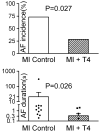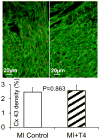Thyroid hormone replacement therapy attenuates atrial remodeling and reduces atrial fibrillation inducibility in a rat myocardial infarction-heart failure model
- PMID: 25305503
- PMCID: PMC4250313
- DOI: 10.1016/j.cardfail.2014.10.003
Thyroid hormone replacement therapy attenuates atrial remodeling and reduces atrial fibrillation inducibility in a rat myocardial infarction-heart failure model
Abstract
Background: Heart failure (HF) is associated with increased atrial fibrillation (AF) risk. Accumulating evidence suggests the presence of myocardial tissue hypothyroidism in HF, which may contribute to HF development. In a recent report we demonstrated that hypothyroidism, like hyperthyroidism, leads to increased AF inducibility. The present study was designed to investigate the effect of thyroid hormone (TH) replacement therapy on AF arrhythmogenesis in HF.
Methods and results: Myocardial infarction (MI) was produced in rats by means of coronary artery ligation. Rats with large MIs (>40%) were randomized into L-thyroxine (T4; n = 14) and placebo (n = 15) groups 2 weeks after MI. Rats received 3.3 mg T4 (in 60-day release form) or placebo pellets for 2 months. Compared with the placebo, T4 treatment improved cardiac function and decreased left ventricular internal diameters as well as left atrial diameter. T4 treatment attenuated atrial effective refractory period prolongation (45 ± 1.5 ms in placebo group vs 37 ± 1.6 ms in T4 group; P < .01) and reduced AF inducibility (AF/atrial flutter/tachycardia were inducible in 11/15 rats [73%] in the placebo- vs 4/14 rats [29%] in the T4-treated group; P < .05). Arrhythmia reduction was associated with decreased atrial fibrosis but was not associated with connexin 43 changes.
Conclusions: To our knowledge this is the first study demonstrating that TH replacement therapy in HF attenuates atrial remodeling and reduces AF inducibility after MI-HF. Clinical studies are needed to confirm such benefits in human patients.
Keywords: Atrial fibrillation; arrhythmogenesis; heart failure; thyroid hormone.
Copyright © 2014 Elsevier Inc. All rights reserved.
Conflict of interest statement
Figures






References
-
- Braunwald E. Shattuck lecture--cardiovascular medicine at the turn of the millennium: triumphs, concerns, and opportunities. The New England journal of medicine. 1997;337:1360–9. - PubMed
-
- Seiler J, Stevenson WG. Atrial fibrillation in congestive heart failure. Cardiology in review. 2010;18:38–50. - PubMed
-
- Feinberg WM, Blackshear JL, Laupacis A, Kronmal R, Hart RG. Prevalence, age distribution, and gender of patients with atrial fibrillation. Analysis and implications. Archives of internal medicine. 1995;155:469–73. - PubMed
-
- Go AS, Hylek EM, Phillips KA, Chang Y, Henault LE, Selby JV, Singer DE. Prevalence of diagnosed atrial fibrillation in adults: national implications for rhythm management and stroke prevention: the AnTicoagulation and Risk Factors in Atrial Fibrillation (ATRIA) Study. JAMA: the journal of the American Medical Association. 2001;285:2370–5. - PubMed
-
- Lloyd-Jones D, Adams R, Carnethon M, De Simone G, Ferguson TB, Flegal K, Ford E, Furie K, Go A, Greenlund K, Haase N, Hailpern S, Ho M, Howard V, Kissela B, Kittner S, Lackland D, Lisabeth L, Marelli A, McDermott M, Meigs J, Mozaffarian D, Nichol G, O’Donnell C, Roger V, Rosamond W, Sacco R, Sorlie P, Stafford R, Steinberger J, Thom T, Wasserthiel-Smoller S, Wong N, Wylie-Rosett J, Hong Y. Heart disease and stroke statistics--2009 update: a report from the American Heart Association Statistics Committee and Stroke Statistics Subcommittee. Circulation. 2009;119:480–6. - PubMed
Publication types
MeSH terms
Substances
Grants and funding
LinkOut - more resources
Full Text Sources
Other Literature Sources
Medical
Research Materials
Miscellaneous

